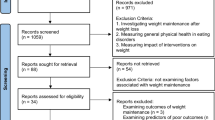Abstract
Overweight or obesity is an established negative prognostic factor in breast cancer. Co-morbidities associated with obesity, including cardiovascular disease (CVD), may negatively impact quality of life and survival in this population. Our purpose was to determine the effect of a cognitive behavioral therapy (CBT) intervention for weight loss through exercise and diet modification on risk factors for recurrence of breast cancer, and risks for CVD associated with obesity. Eighty-five overweight or obese breast cancer survivors were randomly assigned to a once weekly, 16-week intervention or wait-list control group. The intervention incorporated elements of CBT for obesity, addressing a reduction in energy intake, as well exercise, with a goal of an average of 1 h a day of moderate to vigorous activity. Body weight, total and regional body fat (by dual energy X-ray absorptiometry), waist and hip circumference, and blood lipids were assessed at baseline and following 16 weeks of intervention. Results: Seventy six women (89.4%) completed the intervention. Independent t-test to evaluate group differences at 16 weeks showed significant differences in weight, body mass index, percent fat, trunk fat, leg fat, as well as waist and hip circumference between intervention and control groups (P ≤ 0.05). Furthermore, levels of triglycerides and total cholesterol/high density lipoprotein cholesterol levels were also significantly reduced following the intervention. These results indicate that 16 weeks of a CBT program for weight management may reduce obesity and CVD risk in overweight breast cancer survivors.
Similar content being viewed by others
References
Jemal A, Murray T, Ward E et al (2005) Cancer statistics, 2005. CA Cancer J Clin 55:10–30
American Cancer Society (2005) Cancer Facts and Figures 2005. Atlanta
Rock CL, Demark-Wahnefried W (2002) Nutrition and survival after the diagnosis of breast cancer: a review of the evidence. J Clin Oncol 20:3302–3316
McTiernan A (2005) Obesity and cancer: the risks, science, and potential management strategies. Oncology (Williston Park) 19:871–881; discussion 881–872, 885–876
Herman DR, Ganz PA, Petersen L et al (2005) Obesity and cardiovascular risk factors in younger breast cancer survivors: the Cancer and Menopause Study (CAMS). Breast Cancer Res Treat 93:13–23
Irwin ML, McTiernan A, Bernstein L et al (2004) Physical activity levels among breast cancer survivors. Med Sci Sports Exer 36:1484–1491
Wessel TR, Arant CB, Olson MB et al (2004) Relationship of physical fitness vs body mass index with coronary artery disease and cardiovascular events in women. Jama 292:1179–1187
McTiernan A, Ulrich C, Kumai C et al (1998) Anthropometric and hormone effects of an 8-week exercise-diet intervention in breast cancer patients: results of a pilot study. Cancer Epidem Biomar Prev 7:477–481
Fairey AS, Courneya KS, Field CJ et al (2005) Effect of exercise training on C-reactive protein in postmenopausal breast cancer survivors: a randomized controlled trial. Brain Behav Immun 19:381–388
Canadian Society for Exercise Physiology (1994) PAR-Q and you. Gloucester, Ontario
Blair SN, Haskell WL, Ho P et al (1985) Assessment of habitual physical activity by a seven-day recall in a community survey and controlled experiments. Am J Epidemiol 122:794–804
Gross LD, Sallis JF, Buono MJ et al (1990) Reliability of interviewers using the 7-day physical activity recall. Res Q Exerc Sport 61:321–325
Hu FB (2003) Overweight and obesity in women: health risks and consequences. J Womens Health (Larchmt) 12:163–172
Chlebowski RT, Aiello E,McTiernan A (2002) Weight loss in breast cancer patient management. J Clin Oncol 20:1128–1143
Pouliot MC, Despres JP, Lemieux S et al (1994) Waist circumference and abdominal sagittal diameter: best simple anthropometric indexes of abdominal visceral adipose tissue accumulation and related cardiovascular risk in men and women. Am J Cardiol 73:460–468
Cheema BS,Gaul CA (2006) Full-body exercise training improves fitness and quality of life in survivors of breast cancer. J Strength Cond Res 20:14–21
Wilson DB, Porter JS, Parker G et al (2005) Anthropometric changes using a walking intervention in African American breast cancer survivors: a pilot study. Prev Chronic Dis 2:A16
Holmes MD, Chen WY, Feskanich D et al (2005) Physical activity and survival after breast cancer diagnosis. Jama 293:2479–2486
Courneya KS, Mackey JR, Bell GJ et al (2003) Randomized controlled trial of exercise training in postmenopausal breast cancer survivors: cardiopulmonary and quality of life outcomes. J Clin Oncol 21:1660–1668
Kolden GG, Strauman TJ, Ward A et al (2002) A pilot study of group exercise training (GET) for women with primary breast cancer: feasibility and health benefits. Psychooncology 11:447–456
Schmitz KH, Ahmed RL, Hannan PJ et al (2005) Safety and efficacy of weight training in recent breast cancer survivors to alter body composition, insulin, and insulin-like growth factor axis proteins. Cancer Epidemiol Biomar Prev 14:1672–1680
Simpson DR, Dixon BG,Bolli P (2004) Effectiveness of multidisciplinary patient counselling in reducing cardiovascular disease risk factors through nonpharmacological intervention: results from the Healthy Heart Program. Can J Cardiol 20:177–186
Criqui MH,Golomb BA (1998) Epidemiologic aspects of lipid abnormalities. Am J Med 105:48S–57S
Durstine JL, Moore GE (2003) ACSM’s exercise management for persons with chronic diseases and disabilities. Champaign, Ill
Young CE, Karas RH,Kuvin JT (2004) High-density lipoprotein cholesterol and coronary heart disease. Cardiol Rev 12:107–119
Wang Z, Hoy WE (2004) Waist circumference, body mass index, hip circumference and waist-to-hip ratio as predictors of cardiovascular disease in Aboriginal people. Eur J Clin Nutr 58:888–893
Acknowledgements
This study was funded by NIH grants CA90413 and CA101489. We also thank Dennis Heath, MS, and Mila Pruitt for conducting the lipid analysis.
Author information
Authors and Affiliations
Corresponding author
Rights and permissions
About this article
Cite this article
Mefferd, K., Nichols, J.F., Pakiz, B. et al. A cognitive behavioral therapy intervention to promote weight loss improves body composition and blood lipid profiles among overweight breast cancer survivors. Breast Cancer Res Treat 104, 145–152 (2007). https://doi.org/10.1007/s10549-006-9410-x
Received:
Accepted:
Published:
Issue Date:
DOI: https://doi.org/10.1007/s10549-006-9410-x




